Tags
Antoine Augereau, barf board, Benjamin Eliot, boards, book, bookbinders, bookmaking, Boston, Church of Jesus Christ of Latter-day Saints, Colonial America, conservators, Coptic, delaminate, Deseret News, exhibition, felts, fibers, fore-edge, Jim Croft, Jonathan Sandberg, medullary ray, Old Ways of Making Books, paper, paper mill, papermaking, Paris, pasteboard, rare book collections, Samuel Willard, scabbard, scaleboard, Scott Beadles, screen, Simon de Colines, vat, vellum, water, waterleaf, wood, wooden boards, workshop
Judge a book by it’s cover all you want. That cover just keeps on doing what it does best: protecting the book’s text. Covers allows a book to continue to convey information by taking the wear and tear of everyday use. Through the years different materials have been used to cover books.
Wood. Early books were most commonly covered with wooden boards. Rare Books has several manuscripts with Coptic bindings. These books are well-used, with uncovered wooden boards that are polished by handling, but they are often broken and then repaired with linen thread. The wood is sometimes cut similarly to modern lumber, in a straight line across the log. In the picture below you can see the curve of the tree’s growth rings. Wood is porous and expands and contracts as it takes on or loses moisture from the air. It will expand unevenly around that natural curve, warping and sometimes even cracking the board. The strongest wood boards are cut in a very different way.
Imagine you are looking down on the round end of a log. If you cut this log radially from the center as if it was a pie, two useful things happen. First, boards cut like this (called a quarter cut) resist warping because the grain of the wood is running straight up your board, instead of curving through it. Looking at the boards from the top you see little to none of the curve of the tree’s rings. This board will warp very little as humidity changes. Second, there is a structural feature in wood called the medullary ray. These rays go through the wood from the core out to the bark. They are perpendicular to the main grain of the wood, forming a remarkably durable natural plywood. Many Coptic boards break because they are made with wood that does not have prominent medullary rays.
In the above image, notice the faint curve of the grain near the middle of the left board.
In the image below, we can see the medullary rays and the tree’s grain weaving together. The lighter lines are medullary rays, the darker lines are the tree’s grain creating a strong internal structure.
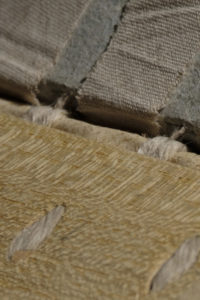
Handmade book
by Jonathan Sandberg from raw materials
at Jim Croft’s “Old Ways of Making Books” workshop
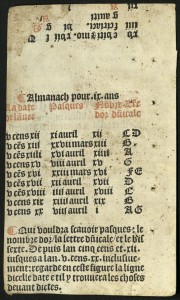
He kaine diatheke
Paris: [Antoine Augereau for] Simon de Colines, [29 November or 22 December] 1534
BS1965 1534
Pasteboard. All this picky woodwork added complications to the bookmaking process. When bookmakers discovered that they could just paste together paper proofs, misprints, or offcuts to make functional boards, it became common practice to do just that. This has made for interesting discoveries as modern conservators re-bind historical books and find that their boards are made of interesting or rare texts.
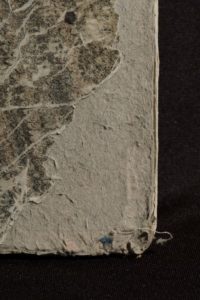
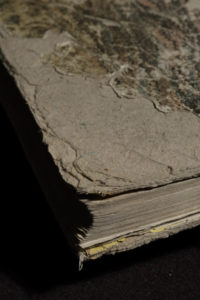
Deseret News
By Church of Jesus Christ of Latter-day Saints
Volume 6. March 1856-March 1866
Uncatalogued
Waterleaf. Around the mid-sixteenth century, very soon after pasteboard began to be used, another technique for making boards was developed. If you are familiar with historical papermaking, or you’ve seen our recent paper exhibition, Paper is Fundamental, you know that paper was made by drawing suspended fibers out of a vat of water on a screen, which was then rolled onto a stack of felts. Paper makers found that if they took these raw, wet pieces of paper and compressed them together, it formed a variant of pasteboard that was less likely to separate between pages, or delaminate. Pictured here is a bound volume of the Deseret News from 1856. The very worn board is beginning to delaminate which gives us a great view of individual “pages.” Because the board is never printed on directly and almost always covered, papermakers could include fiber that would normally be unacceptable for papermaking. Here you see small pieces of cloth and thread. Historical bookmaker Jim Croft calls this kind of board “barf board” because of the jumble of reject fibers that go into its production.
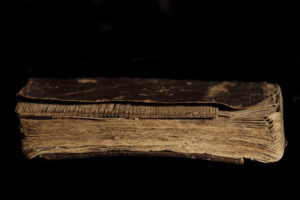
The Peril of the Times Displayed
Samuel Willard
Boston : Printed by B Green & J Allen sold by Benjamin Eliot 1700
BX7233 W4292 P47 1700
Scaleboard. The first paper mill in Colonial America wasn’t established until 1690. Rather than using expensive, imported book boards, bookbinders often used thin scales of wood in their place. These scaleboards, originally called scabbards, were much too brittle for the task of protecting a book, but when covered in paper or leather they made perfectly usable covers. This book was printed in Boston in the year 1700. The leather is now peeling away, allowing us to look at the wood scale beneath. The end grain of the board is visible at the fore-edge and spine of the book, instead of the traditional head and tail. It may be quarter-cut, the end grain shows only a slight curve. The board is a little warped, but the book has been through a lot, and scaleboard wasn’t expected to do the same heavy structural work as early wooden book boards were.
~Contributed by Jonathan Sandberg, Rare Books Assistant, with photographs by Scott Beadles, Rare Books Specialist

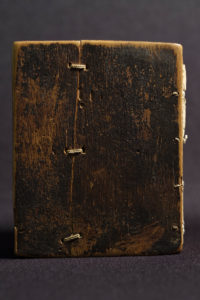
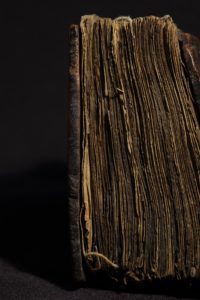
You must be logged in to post a comment.